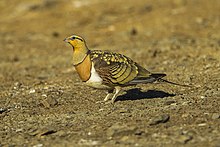| Pin-tailed sandgrouse | |
|---|---|

| |
| Scientific classification | |
| Domain: | Eukaryota |
| Kingdom: | Animalia |
| Phylum: | Chordata |
| Class: | Aves |
| Order: | Pterocliformes |
| Family: | Pteroclidae |
| Genus: | Pterocles |
| Species: | P. alchata
|
| Binomial name | |
| Pterocles alchata (Linnaeus, 1766)
| |
| Synonyms | |
|
Tetrao alchata Linnaeus, 1766 | |
The pin-tailed sandgrouse (Pterocles alchata) is a medium large bird in the sandgrouse family. It has a small, pigeon-like head and neck and a sturdy, compact body. It has long pointed wings, which are white underneath, a long tail and a fast direct flight. Flocks fly to watering holes at dawn. The call is a loud kattar-kattar. This gregarious species breeds on dry open treeless plains and similar habitats. Its nest is a ground scrape into which two or three cream-coloured eggs with cryptic markings are laid. Both sexes incubate the eggs.
The pin-tailed sandgrouse is about 35 centimetres (14 in) long. Its head and upperparts are yellowish-green. The underparts are white with a chestnut breast band separating the belly from the green neck. Sexes are somewhat similar, but the female is better camouflaged and has a shorter tail than the male. There are two subspecies; P. a. alchata breeds in southern Europe and P. a. caudacutus breeds in northwestern Africa, the Middle East and southeastern Asia. It is a partial migrant, with some Asian birds moving to the Middle East and northern Pakistan in winter. Males of the eastern race have duller underparts than the European birds, and the females have white, rather than yellow, wing coverts.
- ^ BirdLife International (2019). "Pterocles alchata". IUCN Red List of Threatened Species. 2019: e.T22692983A155616576. doi:10.2305/IUCN.UK.2018-2.RLTS.T22692983A155616576.en. Retrieved 12 November 2021.
